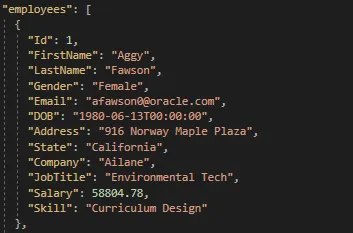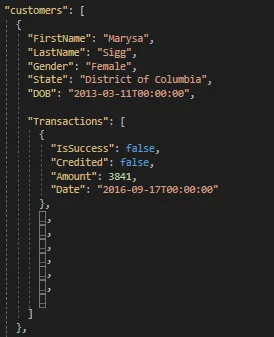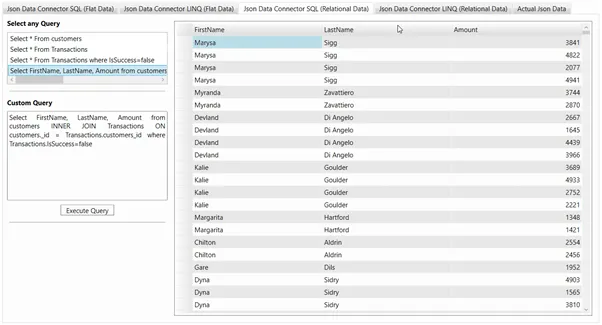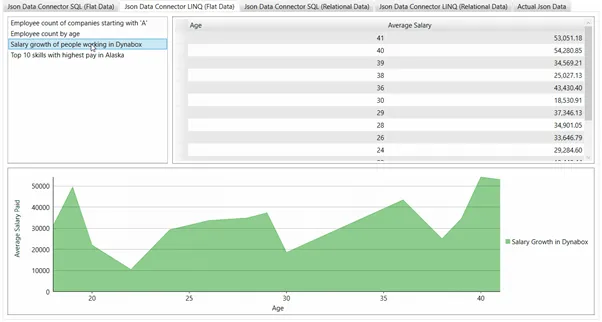如何使用 SQL、LINQ ADO.NET 在 C# 中查询 JSON

在当今互联互通的世界中,数据堆积得非常快。我们生成的数据比人类历史上任何时候都多,而且很多数据都以非关系格式存储,如JSON文档。JSON已经成为现代应用程序的一种无处不在的格式,用于配置文件、API、客户端和服务器之间的数据传输、数据存储等。鉴于其简单性,处理 JSON 数据绝非易事。
在这篇博客中,我们将介绍 ComponentOne DataConnector for JSON,它提供了一种使用 ADO.NET 或 Entity Framework Core 连接到 JSON 数据的轻松方法。我们将讨论如何使用 C1 ADO。用于 JSON 的 NET 提供程序,用于使用 SQL 和 LINQ 查询 JSON 数据。
如何使用 SQL 查询 JSON
在此过程中,我们将遵循与使用数据库时通常使用的方法相同的方法,即:
- 创建连接字符串
- 创建连接对象
- 使用 SQL 查询数据
但首先,让我们从安装所需的 NuGet 包开始。
- 打开“项目”菜单,然后选择**“管理 NuGet 包”。**
- 浏览“C1.AdoNet的。Json' NuGet 包,然后单击“安装”。
创建连接字符串
为了与数据源连接,我们需要一个连接字符串。我们将使用 C1JsonConnectionStringBuilder 创建连接字符串。创建连接字符串需要三项:
- JSON DataModel:指定用于读取 JSON 数据的访问机制。指定 DataModel,您可以配置如何将对象数组建模为表。可用的不同数据模型包括 Top Level Document Model、Flattened Model 和 Relational Model。你可以在这里阅读更多关于它们的信息。
- Uri:指定 JSON 资源位置的 URI。您可以连接到本地文件或 HTTP 流。
- JSON 路径:指定要从 JSON 内容中读取的节点
下面显示了为平面数据创建连接字符串的示例:
public static class Utils
{
public static string JsonDataPath => "Data\\EmployeesData.json";
public static C1JsonConnectionStringBuilder JsonConnectionBuilder { get; }
static Utils()
{
JsonConnectionBuilder = new C1JsonConnectionStringBuilder()
{
DataModel = "Document",
Uri = JsonDataPath,
JsonPath = "$.employees"
};
}
}
同样,下面演示如何为关系数据创建连接字符串:
public static class Utils
{
public static string JsonCustomerDataPath => "Data\\CustomersData.json";
public static C1JsonConnectionStringBuilder CustomerDataConnectionStringBuilder { get; }
static Utils()
{
CustomerDataConnectionStringBuilder = new C1JsonConnectionStringBuilder()
{
DataModel = "Relational",
Uri = JsonCustomerDataPath,
JsonPath = "$.customers;$.customers.Transactions"
};
}
}
若要了解有关连接字符串格式的详细信息,请参阅此处。
如何创建连接对象
现在,我们已经有了连接字符串,因此下一步是使用 C1JsonConnection 类初始化连接实例,如下所示:
private void CreateJsonConnection()
{
_jsonConnection = new C1JsonConnection(\_connBuilder.ConnectionString);
}
使用 SQL 查询数据
现在连接已准备就绪,我们可以通过创建 C1JsonDataAdapter 的对象来使用 SQL 查询数据,如下所示:
C1JsonDataAdapter adapter = new C1JsonDataAdapter(_jsonConnection, sql);
var table = new DataTable();
adapter.Fill(table);
下面显示了一个示例平面数据以及相同的相应查询:

C1JsonDataAdapter adapter = new C1JsonDataAdapter(\_jsonConnection, “select * from employees”);
var table = new DataTable();
adapter.Fill(table);
对于关系数据,它可能看起来像这样:

C1JsonDataAdapter adapter = new C1JsonDataAdapter(_jsonConnection, (“Select FirstName, LastName, Amount from customers INNER JOIN Transactions ON customers._id = Transactions.customers_id where Transactions.IsSuccess=false”);
var table = new DataTable();
adapter.Fill(table);
填充 DataTable 后,数据可以显示在网格中,如下所示:

在 Entity Framework Core 中使用 LINQ 查询 JSON
在本节中,我们将讨论如何在 Entity Framework Core 中使用 LINQ 查询 JSON 数据。让我们首先安装所需的 NuGet 包,即 C1。EntityFrameworkCore.Json
安装 NuGet 包后,接下来需要设置 DbContext 并向 JSON 数据源提供连接字符串。为此,我们将使用 C1JsonConnectionStringBuilder,如下所示:
public abstract partial class DocumentContext : DbContext
{
private C1JsonConnectionStringBuilder _builder;
public DocumentContext(C1JsonConnectionStringBuilder builder)
{
_builder = builder;
Database.AutoTransactionsEnabled = false;
}
public DocumentContext(DbContextOptions<DocumentContext> options)
: base(options)
{
Database.AutoTransactionsEnabled = false;
}
protected override void OnConfiguring(DbContextOptionsBuilder optionsBuilder)
{
if (!optionsBuilder.IsConfigured)
{
optionsBuilder.UseJson(_builder.ConnectionString);
}
}
}
如何创建 DbContext
上面的 DocumentContext 类可以用作 JSON 文档的 DbContext 的基类。可以在子类中定义模型实体。
下面显示了平面 JSON 数据源的 DbContext 示例:
public class EmployeesContext : DocumentContext
{
public virtual DbSet<Employee> Employees { get; set; }
public EmployeesContext() : base(Utils.JsonConnectionBuilder) { }
protected override void OnModelCreating(ModelBuilder modelBuilder)
{
modelBuilder.Entity<Employee>(entity =>
{
entity.ToTable("employees");
entity.HasKey(x => x.Id);
entity.Property(e => e.Id).HasColumnName("Id");
entity.Property(e => e.FirstName).HasColumnName("FirstName");
entity.Property(e => e.LastName).HasColumnName("LastName");
entity.Property(e => e.Email).HasColumnName("Email");
entity.Property(e => e.DOB).HasColumnName("DOB");
entity.Property(e => e.Address).HasColumnName("Address");
entity.Property(e => e.State).HasColumnName("State");
entity.Property(e => e.Company).HasColumnName("Company");
entity.Property(e => e.Gender).HasColumnName("Gender");
entity.Property(e => e.JobTitle).HasColumnName("JobTitle");
entity.Property(e => e.Skill).HasColumnName("Skill");
entity.Property(e => e.Salary).HasColumnName("Salary");
});
}
}
下面显示了关系 JSON 数据源的 DbContext 示例:
public class CustomersContext : DocumentContext
{
public virtual DbSet<Customer> Customers { get; set; }
public virtual DbSet<Transaction> Transactions { get; set; }
public CustomersContext() : base(Utils.CustomerDataConnectionStringBuilder) { }
protected override void OnModelCreating(ModelBuilder modelBuilder)
{
modelBuilder.Entity<Transaction>(entity =>
{
entity.ToTable("Transactions");
entity.HasOne(e => e.Customer).WithMany(x => x.Transactions).HasForeignKey("customers_id");
entity.Property(e => e.Id).HasColumnName("_id");
entity.Property(e => e.Amount).HasColumnName("Amount");
entity.Property(e => e.Credited).HasColumnName("Credited");
entity.Property(e => e.IsSuccess).HasColumnName("IsSuccess");
entity.Property(e => e.Date).HasColumnName("Date");
});
modelBuilder.Entity<Customer>(entity =>
{
entity.ToTable("customers");
entity.Property(e => e.Id).HasColumnName("_id");
entity.Property(e => e.FirstName).HasColumnName("FirstName");
entity.Property(e => e.LastName).HasColumnName("LastName");
entity.Property(e => e.DOB).HasColumnName("DOB");
entity.Property(e => e.State).HasColumnName("State");
entity.Property(e => e.Gender).HasColumnName("Gender");
});
}
}
使用 ComponentOne DataConnectors 基架功能,可以自动生成这些类。它是通过运行 Scaffold-DbContext 命令生成的。有关详细信息,请参阅文档中的基架主题。
使用 LINQ 查询 DbContext
设置 DbContext 后,可以使用 LINQ 查询 JSON 数据源。我们可以同时使用 Query 语法或 Method 语法:
_context = new EmployeesContext();
var employees = await _context.Employees.ToListAsync();
// Employee count of companies starting with 'A'
var employeeCountData = from employee in employees
where employee.Company.StartsWith("A", StringComparison.OrdinalIgnoreCase)
group employee by employee.Company into grp
select new { Company = grp.Key, NumberOfEmployees = grp.Count() };
// Salary growth of people working in Dynabox
var salaryGrowthData = employees
.Where(x => x.Company == "Dynabox").OrderBy(x => x.DOB)
.Select(x => new { Age = DateTime.Now.Year - x.DOB.Year, Salary = x.Salary })
.Where(x => x.Age >= 18)
.GroupBy(x => x.Age)
.Select(x => new { Age = x.Key, AverageSalary = x.Select(o => o.Salary).Average() });
然后可以在网格/图表中使用数据,如下所示:

结论
在这篇博客中,我们看到了使用 C1 ADO 查询平面/关系 JSON 数据。JSON 的 NET 提供程序。虽然这篇博客展示了 ADO 的基本用法。JSON 的 NET 提供程序,该库还提供高级功能。